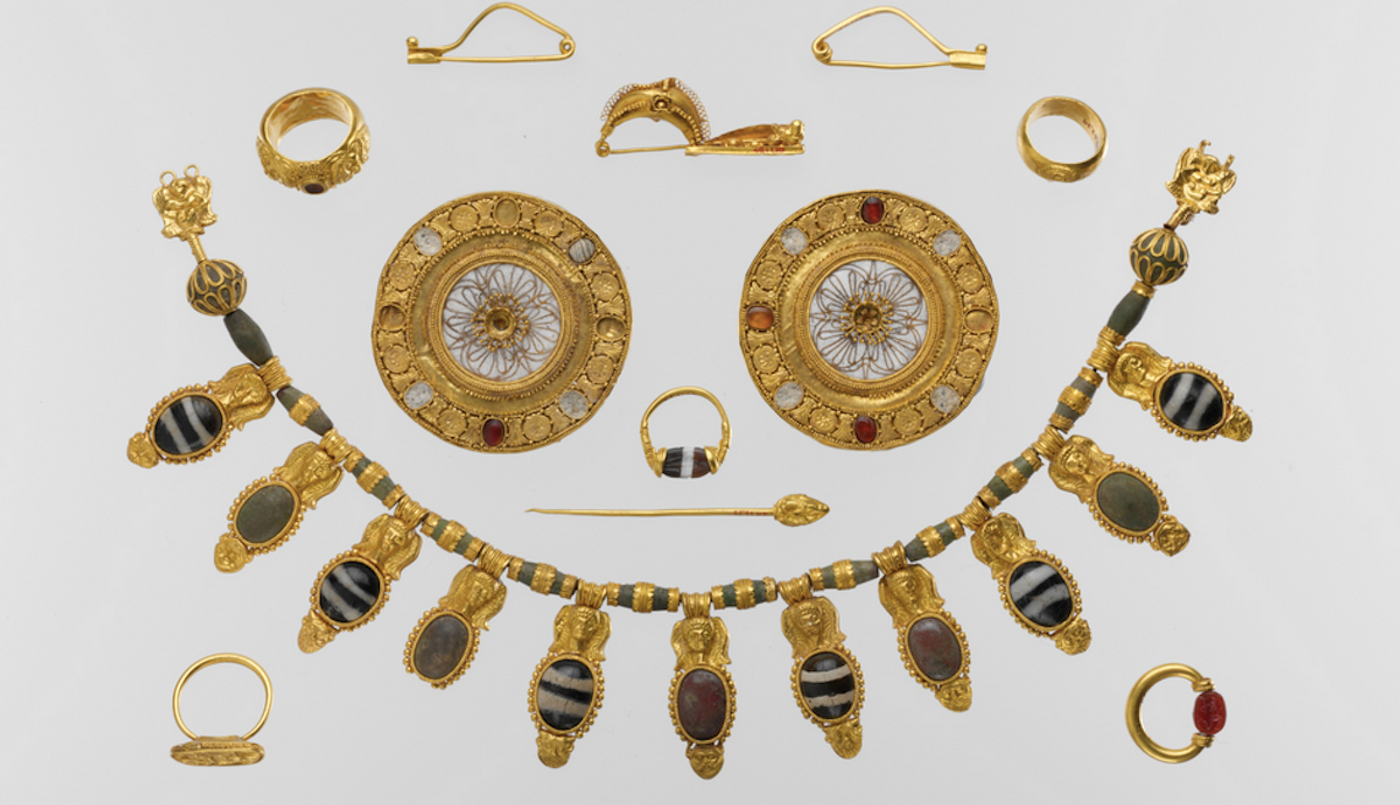Who Were the Etruscans? A Genetic Study Provides Some Answers
The Etruscans lived in what is now Italy from about 800 BCE to the first century BCE when they were assimilated into the Roman Empire. Their language is now gone, but some of their culture has survived because of their notable metallurgical skills. Their origins have been a subject of debate because they seemed to have little in common with their neighbors; their language was not Indo-European and their civilization is thought to have been comparatively unique. But new genetic research analyzing Etruscan DNA from 82 ancient people found in central and southern Italy has shown that they did have close ties to their neighbors in the Mediterranean.
Above: A particularly impressive set of Etruscan jewelry including rings, earrings, a dress pin, and a necklace, from the early 5th century BCE / Image credit: Public Domain, courtesy of The Metropolitan Museum of Art
Most of what historians and researchers know about the Etruscans comes from accounts by Greek and Roman writers, who came along later. There was already speculation in ancient circles about the history of the Etruscans. Herodotus, for example, thought that they were descendants of Anatolian or Aegean migrants.
In current times, archaeologists generally have surmised that Etruscan people were originally from the area. This research has provided some evidence to back that theory up, with genetic data that was recovered from a dozen sites, and spans nearly 2,000 years.
Genome-wide analytical tools have now indicated that Etruscans were not from Anatolia. The findings have been reported in Science Advances. The work determined that Etruscans had a genetic profile that was similar to Latin people who lived in neighboring Rome, and carried some ancestry from Eurasian steppe people of the Bronze Age.
Indo-European languages are now spoken widely around the world, and steppe people probably helped usher in those languages. The persistence of a language with different origins hasn't yet been explained; there are no parent languages to Etruscan and no descendants. There aren't any surviving texts from the Etruscan people, and what little scholars know about the language comes from short inscriptions made on stuff that they used in daily life, religious rites, or funerals, and one longer piece of writing on linen that happened to be used to wrap mummies in Egypt. The language used a Greek script, though some letters were inverted.
“This linguistic persistence, combined with a genetic turnover, challenges simple assumptions that genes equal languages and suggests a more complex scenario that may have involved the assimilation of early Italic speakers by the Etruscan speech community, possibly during a prolonged period of admixture over the second millennium BCE,” suggested study co-author David Caramelli, a Professor at the University of Florence.
While the study identified a few people with North African, Central European, and Eastern Mediterranean origins, the genetics of Etruscans remained generally stable for 800 years or more. The civilization spanned the Iron Age and Roman Republic, but in the Roman Imperial period that followed, there was a huge genetic shift in central Italy. At that time, Eastern mediterranean populations, possibly including slaves and soldiers, changed the whole population.
“This genetic shift clearly depicts the role of the Roman Empire in the large-scale displacement of people in a time of enhanced upward or downward socioeconomic and geographic mobility,” said senior study author Johannes Krause, the Director at the Max Planck Institute for Evolutionary Anthropology.
Sources: Max Planck Institute for the Science of Human History, Science Advances







![Everything You Need To Know About NGS [eBook]](https://d3bkbkx82g74b8.cloudfront.net/eyJidWNrZXQiOiJsYWJyb290cy1pbWFnZXMiLCJrZXkiOiJjb250ZW50X2FydGljbGVfcHJvZmlsZV9pbWFnZV9mNTM1ZjIyYzA5MDE5ZmNmMWU5NmI0ZDc4NWU2MzdiZTZlN2I5ZDk5XzE4NDUuanBnIiwiZWRpdHMiOnsidG9Gb3JtYXQiOiJqcGciLCJyZXNpemUiOnsid2lkdGgiOjcwMCwiaGVpZ2h0IjozNTAsImZpdCI6ImNvdmVyIiwicG9zaXRpb24iOiJjZW50ZXIiLCJiYWNrZ3JvdW5kIjoiI2ZmZiJ9LCJmbGF0dGVuIjp7ImJhY2tncm91bmQiOiIjZmZmIn19fQ==)

